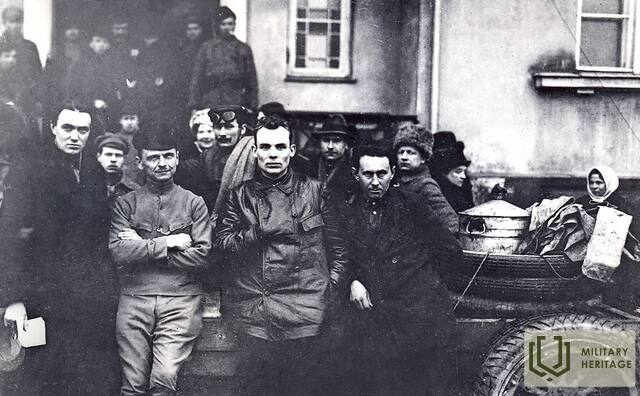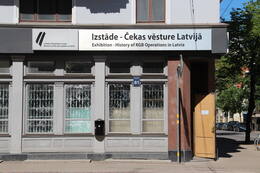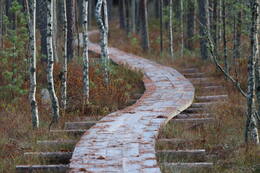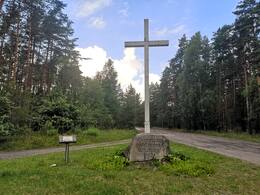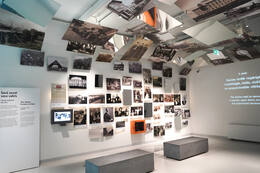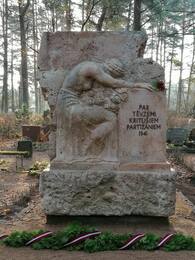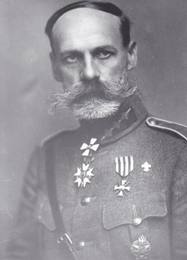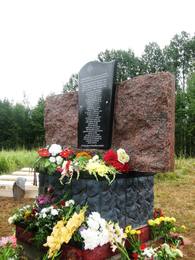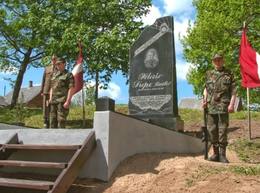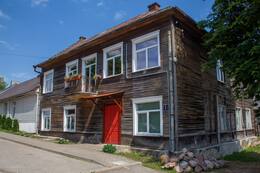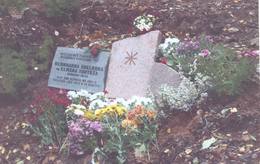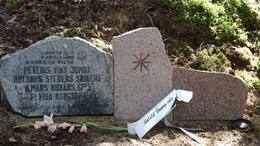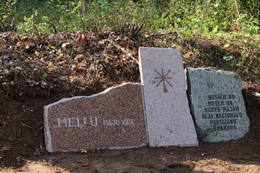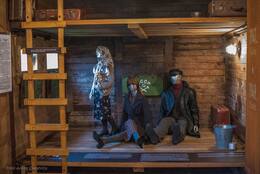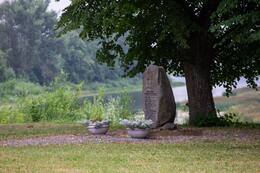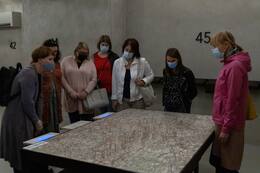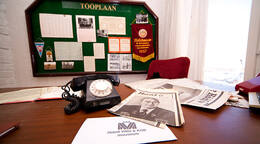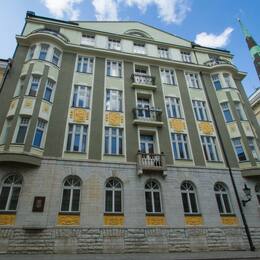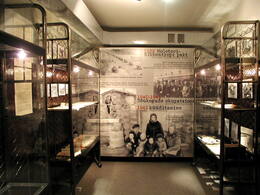Dig II Antrasis pasaulinis karas
Vienas iš SSRS valdžios ramsčių buvo speciali represinė struktūra, populiariai vadinama Čeka. Bolševikai ją sukūrė netrukus po to, kai 1917 m. gruodį atėjo į valdžią Rusijoje. Buvo sudaryta Visos Rusijos ypatingoji komisija, kurios tikslas buvo ieškoti ir fiziškai numalšinti bolševikų oponentus. Komisijos pavadinimas rusų kalba – Vserosijskaja Črezvičajna Komisija – buvo sutrumpintas iki Čekos. Taip atsirado žodis, kuris vėlesniais metais buvo vartojamas visai represinei sistemai įvardyti, nepriklausomai nuo to, kaip keitėsi jos oficialus pavadinimas.
1940 m. birželio 17 d. kartu su reguliariąja SSRS kariuomene į Latviją įžengė specialieji vidaus reikalų kariuomenės daliniai, kurie pradėjo Čekos veiklą. Ji veikė Latvijoje iki 1991 m. ir yra atsakinga už tūkstančių Latvijos piliečių mirtį, fizines ir moralines kančias.
Čekos veikla Latvijoje yra glaudžiai susijusi su pastatu Brīvības ir Stabu gatvių kampe. Įstaiga pradėjo jį pertvarkyti savo reikmėms netrukus po okupacijos pradžios 1940 m. rugsėjį. Jame buvo kalinami, tardomi, o 1940–1941 m. taip pat žudomi Latvijos piliečiai, kuriuos okupacinis režimas laikė priešininkais. 1940 ir 1941 m. buvo iškeltos mažiausiai 3355 politinės baudžiamosios bylos. Daugelis sulaikytųjų vėliau buvo rasti masiniuose kapuose Baltezerse, Babytėje, Dreiliniuose, Stopiniuose, taip pat Rygos centrinio kalėjimo kieme. Prasidėjus karui su Vokietija, 1941 m. birželio pabaigoje Čeka į SSRS kalėjimus išvežė apie 3600 politinių kalinių. Iš viso politinis persekiojimas 1940–1941 m. tiesiogiai paveikė apie 26 000 Latvijos gyventojų.
Sovietų valdžios priešininkų slopinimas tęsėsi ir po Antrojo pasaulinio karo, daugiausia nukreiptas prieš Latvijos nacionalinius partizanus ir antisovietinio pasipriešinimo judėjimo dalyvius. Pokario metais tyrimai buvo vykdomi Kampiniame name, tačiau mirties bausmės buvo vykdomos Rygos centriniame kalėjime. Čekos veiklos metodai šiek tiek pasikeitė po Stalino mirties 1953 m. Fizinius kankinimus pakeitė psichologiniai.
Vėlesniais metais, kai pasipriešinimas sovietų režimui buvo veiksmingai nuslopintas, fizinės represijos buvo retos, tačiau Čeka vis dar kontroliavo visuomenę ir laikė ją baimės gniaužtuose. Čekos veikimo metodai Latvijoje nebuvo išsamiai ir iki galo ištirti dėl dokumentų trūkumo. Tyrimo bylos ir Čekos laisvai samdomų agentų kortelės saugomos Latvijoje, tačiau darbuotojų sąrašai ir tarnybos bylos – Rusijoje. Jos nėra prieinamos Latvijos valdžios institucijoms ir tyrėjams.
Daugiau informacijos šaltinių
Latvijos okupacijos muziejus / Kas buvo tas čekis? Prieinama: http://okupacijasmuzejs.lv/lv/apmekle/izstade-cekas-vesture-latvija/kas-bija-ceka/ [žiūrėta 2021-05-06]
Susijusi laiko juosta
Susijusios vietos
Paroda KGB pastate „KGB operacijų Latvijoje istorija“
Buvęs SSRS Valstybės saugumo komiteto (paprastai vadinamas Čeka) pastatas atviras lankytojams. Čia čekistai kalindavo, tardydavo ir žudydavo Latvijos piliečius, kuriuos okupacinis režimas laikė priešininkais. Taip pat eksponuojama Latvijos okupacijos muziejaus ekspozicija apie Čekos veiklą Latvijoje. Siūlomos ekskursijos po kalėjimo kameras, koridorius, rūsį ir kiemą. Namas pastatytas 1911 m. ir yra vienas gražiausių pastatų Rygoje. Liaudyje vadinamas „Kampiniu namu“, jis buvo baisiausias sovietinio okupacinio režimo simbolis Latvijoje ir vienas iš SSRS valdžios ramsčių. Čeka iš Kampinio namo veikė okupacijos metu nuo 1940 iki 1941 m., o vėliau nuo 1945 iki 1991 m. Dešimtys tūkstančių latvių nukentėjo nuo tiesioginio politinio persekiojimo. Kova su sovietų valdžios priešais tęsėsi ir po Antrojo pasaulinio karo. Čekos požiūris į savo veiklą šiek tiek pasikeitė po Stalino mirties. Fizinį kankinimą pakeitė psichologinis teroras. Dauguma Čekos agentų buvo latviai (52 %). Antra pagal dydį grupė buvo rusai – 23,7 %. 60,3 % agentų nebuvo Komunistų partijos nariai. 26,9 % agentų turėjo aukštąjį išsilavinimą. Sistema buvo sukurta taip, kad įtrauktų vietos gyventojus ir taip turėtų didesnę kontrolę visuomenėje. Personalo dokumentai ir tarnybos įrašai yra Rusijoje. Ši medžiaga nebuvo prieinama Latvijos valdžios institucijoms ir tyrėjams.
Nacionalinių partizanų būstinė gamtos draustinyje „Stompakų pelkės“ (Stompaku purvi)
Antrojo pasaulinio karo metais Stompakų pelkėje buvo viena didžiausių nacionalinių partizanų būstinių Baltijos šalyse. Šiandien ši teritorija priklauso Stompakų gamtos draustiniui. Pelkių salose esančią gyvenvietę galima pasiekti pažymėtu pėsčiųjų taku.
1945 m. pradžioje Stompakų pelkėje buvusioje nacionalinių partizanų būstinėje gyveno 350–360 žmonių, iš jų – 40 50 moterų. Joje buvo 24 gyvenamieji bunkeriai – pusiau į žemę įkasti statiniai, kuriuose galėjo gyventi 3–8 žmonės. Būstinėje taip pat veikė kepykla, požeminė bažnyčia ir trys antžeminės pašiūrės arkliams. Partizanai rengė išpuolius prieš okupacinio režimo pareigūnus.
1945 m. kovo 2–3 d. čia vyko Stompakų mūšis – didžiausias nacionalinių partizanų susirėmimas Latvijoje. Būstinėje buvusius 350–360 partizanų puolė NKVD 143-asis šaulių pulkas ir vietinio stribų (rus. „isterbiteli“) bataliono kovotojai – iš viso 483 vyrai. Mūšis truko visą kovo 2 dieną. Kovo 3-iosios naktį partizanams pavyko ištrūkti iš būstinės ir pasitraukti į ankstesnės bazės vietą. Mūšyje žuvo 28 partizanai, o NKVD neteko 32 karių.
Šiuo metu Stompakų būstinės vietoje yra atkurti trys bunkeriai – bažnyčia, štabas ir gyvenamasis bunkeris, taip pat 21 bunkerio vieta. Įrengti informaciniai stendai apie būstinę ir mūšį. Galima užsisakyti ekskursijas su gidu.
Memorialas „Baltasis kryžius“ Stopiniuose
Įsikūręs miške 50 m nuo V36 greitkelio, atkarpoje nuo Juglos popieriaus fabriko kaimo iki P4 greitkelio.
Nuo 1941 m. vasario 3 d. iki kovo 25 d. šioje vietoje keturiose duobėse buvo palaidoti 23 žmonės. Aukos buvo sušaudytos Čekos pastate Rygoje. Ekshumacija įvyko 1944 m. balandžio 27 d. Tuo metu buvo identifikuoti 14 palaidotųjų, o šiandien, atlikus tyrimus, identifikuoti visi šioje vietoje palaidoti asmenys.
Baltasis kryžius šioje vietoje buvo pastatytas 1991 m. liepos 12 d. kaip komunistinio okupacinio režimo aukų atminimo ženklas. Baltąjį kryžių pagamino ir pastatė Liaudies fronto nariai ir Stopinių rajono gyventojai. 1998 m. prie Baltojo kryžiaus buvo pastatytas skulptoriaus Uldžio Stergio sukurtas atminimo akmuo su užrašu „Rusijos imperializmo aukoms 1941“.
Čia buvo palaidoti: Jānis Bergmanis (1900-1941), Alberts Bļodnieks (1904-1941), Kārlis Goppers (1876-1941), Arveds Laane (1916-1941), Ernests Ošs-Oše (1882-1941), Jān4 Pace1-1, Jā1901-1. (1897-1941), Arnolds Smala (1912-1941), Jāzeps Stoļers (1903-1941), Walfrīds Vanks (1888-1941), Zenons Vjaksa (1904-1941), Viktors Kopilovs (1904-1941), 1 Kār48 5 Artūrs (1904-1941). (1904-1941), Jevgenijus Simonovas (1896-1941), Eduards-Verners Anerauds (1897-1941), Efraims Gorons (1910-1941), Pēteris āaksa-Timinskis (1913-1941), Paļickis Melbārdis (1949) Izraelis (1911-1941), Jānis Priedītis (1897-1941), Jānis-Arnolds Stālmanis (1913-1941), Aleksandrs Weinbergs (1884-1941).
Latvijos okupacijos muziejus
Muziejuje eksponuojama Latvijos istorija nuo 1940 iki 1991 m., nacistinės Vokietijos ir Sovietų Sąjungos okupacijos laikotarpiu. „Ateities namai“ – tai žinomo Amerikos latvių architekto Gunāro Birkertaus suprojektuoto Okupacijos muziejaus rekonstrukcijos ir išplėtimo projektas, taip pat nauja muziejaus ekspozicija. Ekspoziciją „Čekos istorija Latvijoje“ sukūrė Okupacijos muziejus, ji yra buvusiame SSRS Valstybės saugumo komiteto (KGB) pastate „Kampiniame name“. Latvijos okupacijos muziejus buvo įkurtas 1993 m. Jis pasakoja ilgai slėptą Latvijos valstybės, tautos ir žemės likimo istoriją dviejų užsienio totalitarinių valstybių okupacijos laikotarpiu nuo 1940 iki 1991 m. 2020 m. pabaigoje muziejuje buvo daugiau nei 70 000 įvairių istorinių eksponatų (dokumentų, nuotraukų, rašytinių, žodinių ir daiktinių įrodymų, daiktų ir atminimo dovanų). Muziejaus specialistai įrašė daugiau nei 2400 vaizdo įrašų, todėl tai viena didžiausių okupacijos kolekcijų Europoje. Latvijoje, Lietuvoje ir Estijoje klostęsi įvykiai aiškiai parodo, ką tautoms teko ištverti valdant dviem totalitariniams režimams.
Paminklas „Sėdinčiai motinai“ Inčukalno garbės kapinėse
Yra: Inčukalno savivaldybė, Inčukalns, Miera gatvė, Inčukalno kapinės.
Paminklas atidengtas: 1944 m. liepos 16 d. Paminklas atidengtas po K. Zālės mirties. Užrašas: Žuvusiems Tėvynės partizanams 1941 m. (atkurtas). Paminklas restauruotas 2020 m. lapkričio 5 d. Paminklas restauruotas remiant Inčukalno regioninei tarybai. Restauratorius menininkas Igoris Dobičinas.
Įvykiai: „1940 m. birželio 17 d. Latviją okupavo SSRS. 1941 m. birželio 14 d. buvo vykdomos trėmimai. 1941 m. birželio 22 d. Vokietija užpuolė SSRS, ir Vermachto daliniai įžengė į Latviją. Raudonoji armija ir jos rėmėjai atsitraukė. Daugelyje Latvijos vietų – įskaitant Raganą, Sėją ir Inčukalną – buvę sargybiniai ir patriotiškai nusiteikęs jaunimas organizavosi ginti savo namų ir skubėti išvyti sovietų okupantus. Kai 1941 m. liepos 1 d. Sėjos valsčiaus „Ziediņi“ (Gėlės) rajone vėl buvo iškelta Latvijos Laisvosios Valstybės vėliava, specialieji Raudonosios armijos daliniai Šiaurinėse kapinėse sušaudė šio namo savininkę – 39 metų Elzą Višą, o Sėjos ir Krimuldos valsčių pasienyje – jos motiną – 64 metų Elzą Martinovą. Tai sukėlė dar daugiau neapykantos ir pasipiktinimo tarp vietovės gyventojų, ir jie pradėjo...“ susiburti į liaudies pasipriešinimo judėjimą ir kurti savigynos būrius, kurie dar buvo vadinami pirmaisiais partizanais (Inčukalno grupės vadas buvo Maksis Cālītis). Prie regiono kovotojų prisijungė ir iš Litenės karinės stovyklos pabėgę arba paleisti vadinamojo Latvijos teritorinio korpuso kareiviai bei karininkai. Po kelių dienų, liepos 4 d., įvyko ginkluotas susidūrimas su raudonaisiais, mūšyje žuvo septyni kareiviai ir Raganos vaistininko sūnus Pēteris Prašķēvičs. Be to, Raganos mūšyje buvo sužeistas ir paimtas į nelaisvę 17 metų Rėzeknės mokytojų instituto studentas Jānis Porietis, kuris buvo kankinamas, sušaudytas ir palaidotas netoli Straupės.
Čia, Inčukalnyje, buvo iškastas bendras brolių kapas, į kurį aštuoniais arklių traukiamais vežimais po vieną buvo vežami iš baltų neobliuotų lentų pagaminti karstai, kad žuvę didvyriai galėtų ilsėtis gimtojoje žemėje. Po kelių mėnesių, jau vokiečių okupacijos metu, kapinėse buvo įrengtas Kārlio Zāleso (nuo 1939 m. iki gyvenimo pabaigos 1942 m. vasario 19 d., dėl sunkios ligos genialusis latvių skulptorius pasirinko Inčukalną savo gyvenamąja vieta) suprojektuotas paminklas – sielvartaujančios motinos ant rožių kelių atvaizdas. 1950-aisiais vietos komunistų aktyvistai paminklą susprogdino. Paminklas apgadintas ir nejudantis gulėjo iki pat Atgimimo, kai 1980-ųjų pabaigoje vis daugiau žmonių susidomėjo ir kalbėjo apie 1941 m. liepos 4 d. įvykius bei ragino restauruoti Kārlio Zāleso paminklą. Šis reikalavimas buvo išsakytas 1988 m. rugsėjo 8 d. Inčukalno pradinėje mokykloje sušauktame žmonių ir valdžios susirinkime, kuriame dalyvavo ne tik Inčukalno gyventojai, bet ir netoliese esančių parapijų gyventojai, taip pat Aplinkos apsaugos klubo ir Latvijos nacionalinės komunistų sąjungos nariai iš Rygos.
... Paminklo restauravimo darbuose aktyviai dalyvavo Inčukalno gyventojai – Teodors Ildens, Arvīds Blaus, Pēteris Vorfolomējevs, ... ir daugelis kitų patriotiškai nusiteikusių žmonių. 1989 m. liepos 4 d. naujai atgimęs kilnus ir liūdnas paminklas buvo iškilmingai pašventintas kunigo Vairos Bitēnas.“
Generolo Karlso Gopperso atminimo kambarys jo gimtinėje „Maskati“
Įsikūręs Plani valsčiuje, ant Vijos upės kranto.
Galima aplankyti generolo Kārlio Gopperso atminimo kambarį jo gimtinėje „Maskati“.
„Maskatu“ ūkį valdė generolo brolis Augustas Goppersas, nes talentingas karo vadas buvo užsiėmęs svarbiais įvykiais ir pasauliniais karais. 1920 m. generolas grįžo į Latviją, į gimtuosius namus. Tačiau daugelis atsakingų pareigų jį siejo su Ryga. Augustas toliau vadovavo „Maskatu“. 1940 m. generolas Goppersas buvo suimtas ir 1941 m. kovo 25 d. sušaudytas Čekos rūsiuose. 1944 m. Gopperių šeima su trimis arklių traukiamomis vežimais pabėgo į Kuršą. Karas išskyrė šeimą, o Aleksandro Gopperso dukros – Biruta, Elza ir Ana – liko Latvijoje. Joms nebebuvo leista grįžti į „Maskatu“. Namai buvo dideli ir kruopščiai prižiūrimi. Juose atskiruose kambariuose buvo apgyvendintos trys ar keturios naujokų šeimos. Dideliame tvarte buvo įrengtas arklių ferma. Dėl tarpusavio kivirčų 1980 m. kilo gaisras. Sudegė tvartas ir didelis sandėlis. Laimei, ugnis į namą nepersimetė, liepsnas atbaidė dideli mūsų protėvių sodinti medžiai.
1991 m., po stebuklingo Atgimimo, Latvijos valstybė atgimė antrą kartą. 1992 m. generolo Gopperso brolio Augusto šeima susigrąžino „Maskatus“ kaip savo protėvių šventą vietą. Dešimt metų visi sunkiai dirbo, kad išgelbėtų namus nuo sunaikinimo, atkurtų ir atstatytų sugriautus pastatus, kad visas „Maskatus“ ūkis būtų gražus. Namai buvo atkurti iki senovinės išvaizdos, taip pat įrengtas generolo Kārlio Gopperso atminimo kambarys. Atminimo kambarį galima aplankyti iš anksto paskambinus ir susitarus telefonu +371 29396870, +371 29254285.
Paminklas pasipriešinimo judėjimo dalyviams Stompakyje
Įsikūręs 15 km nuo Balvių, Viljakos kryptimi, dešinėje kelio pusėje.
Matomas atminimo ženklas.
2011 m. rugpjūčio 11 d., minint Latvijos laisvės kovotojų atminimo dieną, Balvu–Viliako plento pakraštyje priešais Stompakų pelkę buvo atidengtas pasipriešinimo judėjimo dalyvių memorialas, skirtas Pēterio Supės tautinių partizanų, žuvusių 1945 m. kovo 2 ir 3 d. mūšiuose, atminimui. Liepos pabaigoje į paminklo pamatus buvo įkasta kapsulė su žinia ateities kartoms. Kapsulėje įdėtas dokumentas su 28 tautinių partizanų, žuvusių 1945 m. kovo 2 ir 3 d. mūšiuose, vardais ir pavardėmis.
„1945 m. vasarį Stompakų pelkės salose, kurias žmonės pradėjo vadinti Stompakų pelkės salelėmis, 2 km nuo Balvų–Viliakos plento, buvo įkurta didžiausia Latvijoje nacionalinė partizanų stovykla, kurioje 22 apkasuose gyveno 360 žmonių. Tarp jų buvo ir legionierių, kurie, legiono divizijai atsitraukiant, su visais ginklais buvo pasilikę tėvo namuose. Siekdami sunaikinti partizanus, 1945 m. kovo 2 d. dviejų Čekos batalionų kareiviai kartu su naikintojais, kurių ginkluotėje taip pat buvo keturi minosvaidžiai, puolė apkasus. Kovos tęsėsi visą dieną, partizanai atkakliai priešinosi, o puolėjai patyrė didelių nuostolių, todėl negalėjo užimti stovyklos ir sunaikinti partizanų. Mūšyje žuvo arba nuo sunkių sužalojimų mirė ir 28 Stompakų pelkės gyventojai. Kitą naktį partizanai mūšiu „praėjo apgultis ir liko nenugalėtas“ prasiveržė pro stovyklas – taip rašė Zigfrīds.“ Apdovanojimų skyriaus Nacionalinio pasipriešinimo judėjimo dalyvių reikalų komisijos pirmininkas Berkis rašo apie Stompako mūšį.
Paminklas Šiaurės Rytų nacionalinių partizanų vadui Pēteriui Supei – „Cinītis“
Pagerbiant nacionalinių partizanų vado Pēterio Supės atminimą, 2005 m. gegužės 28 d. Viliake buvo atidengtas jam skirtas paminklas. Jis stovi netoli Viliakos katalikų bažnyčios, karo metu iškastų apkasų pakraštyje, kur čekistai laidojo sušaudytus nacionalinius partizanus. Po P. Supės paminklu įdėta kapsulė su 386 žuvusių nacionalinių partizanų vardais, mūšių aprašymais ir medžiaga apie partizanų vadą. Akmenyje iškalti žodžiai: „Tau, Latvija, likau ištikimas iki paskutinio atodūsio“.
Paminklą suprojektavo Pēteris Kravalis.
Netoliese yra memorialas Latvijos laisvės kovotojams, žuvusiems Stompaku miške ir kitose mūšių vietose bei nužudytiems čekistų 1944–1956 m.
2008 m. birželio 20 d. dešinėje sienoje buvo atidengta granito lenta su trimis stulpeliais išdėstytais 55 žuvusių partizanų vardais.
Paminklas pastatytas toje vietoje, kur komunistinė okupacinė valdžia kadaise eksponavo nužudytų partizanų palaikus, siekdama įbauginti likusius gyventojus.
Ant greta esančios lentelės išgraviruoti padėkos žodžiai Pēteriui Supei ir Bronislavos Martuževos eilėraštis:
"Kelkis, Piteri Supe,
Siela, kovok kare!
Šiandien tavo kraujo auka,
Iškilo tarp žmonių.
Išeik ir gyvenk amžinai
Jaunystės stiprybėje ir energingoje
Jis plasnoja, plasnoja, plasnoja
"Kylančioje vėliavoje!"
Privati ekspozicija „Abrenės kambariai“ (Abrenes istabas)
Privati ekspozicija „Abrenės kambariai“ įsikūrusi Viliakos mieste, istoriniame pastate. Iš pradžių šis pastatas stovėjo senosios Marienhauzeno turgaus aikštėje. Vėliau čia veikė butai, biurai, įvairios parduotuvės, o Antrojo pasaulinio karo metais – latvių savigynos štabas, gestapas ir čekistų būstinė. Ekspozicijose pristatomi įvairūs Viliakos ir jos apylinkių istorijos laikotarpiai bei įvykiai nuo 1920 iki 1960 metų – kai miestelis priklausė Jaunlatgalės, vėliau Abrenės apskričiai. Tarp eksponatų – Stompakų pelkės partizanų štabo daiktai, pasakojantys apie nacionalinį pasipriešinimą Latgaloje, taip pat dokumentai ir fotografijos iš Nepriklausomybės kovų laikotarpio. Naujausioje ekspozicijoje lankytojai gali susipažinti su kadaise garsia motokroso trasa „Baltasis briedis“
Atminimo lenta Veclaicenės nacionaliniams partizanams bunkerio vietoje
Įsikūręs Veclaicenės valsčiuje, Alūksnės rajone.
Atidaryta 2019 m. spalio 4 d. Akmenkalis Ainārs Zelčs.
1953 m. kovo 13 d. Veclaicenės miškuose, netoli „Korulių“ namų, čekistai aptiko kruopščiai užmaskuotą bunkerį ir suėmė Bernhardą Ābelkoką ir Elmārą Tortūzą.
Bunkeryje buvo rasti ginklai: 2 vokiški šautuvai ir 95 šoviniai, 2 „Parabellum“ pistoletai ir 152 šoviniai.
1949 m. lapkričio 11 d. Čekos agentai sušaudė K. Dokti-Dokteniekus, o jo grupuotė iširo. Po išpuolio B. Ābelkoksas ir E. Tortūzis kurį laiką slapstėsi bunkeryje netoli „Maskalių“ namų, tačiau nuo 1951 m. pavasario, padedami Ilonos Ābolkalnos, įsikūrė bunkerį „Koruliuose“, kur gyveno iki suėmimo.
Nacionalinės partizanų grupės „Jumba“ bunkerio atminimo vieta
Įsikūręs Ziemerso parapijoje, Valstybinio miško 66-ajame kvartale.
Memorialas buvo atidengtas 2020 m. liepos 10 d.
Antrajame Latvijos nacionalinio partizanų judėjimo etape, 1948 m. viduryje, nuo J. Bitāno-Liepačo būrio Mālupē-Bėjos valsčių teritorijoje atsiskyrė 4 asmenų grupė - Vikas Pētersis, Steberas Rolandas, Bukanas Ilgmārs ir Kangsepa Elvīra, kurie pradėjo savarankišką veiklą Ziemeros-Jaunlaicenės-Veclaicenės valsčiuose. Partizanų štabas buvo netoli Estijos sienos, netoli Rygos-Pskovo plento, ant kalvos, gerai įrengtame bunkeryje.
1950 m. kovo 2 d., čekistams aptikus bunkerį, partizanai pasislėpė iš riedulių pastatytame tvarte „Napke“ name Estijos pusėje. Po ilgų ir įnirtingų susišaudymų 1950 m. kovo 3 d. čekistams pavyko tvartą padegti. Ilgmārs Bukāns, Rolands Stebers ir Elvīra Kangsepa sudegė kartu su naujagime dukra. Pēteris Viks iššoko pro tvarto langą ir pasislėpė namo palėpėje, kur buvo rastas ir sušaudytas. Ūkis buvo sudegintas. Visų žuvusių partizanų kūnai buvo išvežti į Alūksnę. Kovotojų žūties vietoje 1990-ųjų pradžioje buvo pastatytas atminimo ženklas. Elvyros Kangsepos dukra, gimusi degančiame tvarte, buvo vardu Liesma.
Atminimo akmuo Ilzenėje, prie „Sarvių“ ir „Melių“ namų.
Įsikūręs Ilzenės valsčiuje, Alūksnės savivaldybėje.
Atminimo akmuo atidengtas 2018 m. rugsėjo 28 d. Akmenkalis Ainārs Zelčs.
Šių Ilzenės valsčiaus namų gyventojai nuo 1944 m. rudens rėmė Voldemaro Andersono („Vec“) vadovaujamus nacionalinius partizanus, kurių bunkeris buvo netoliese, miško tankmėje. 1945 m. lapkričio 23 d. bunkerį apsupo NKVD kareiviai. Mūšyje žuvo devyni kovotojai. Po mūšio buvo rasti 2 kulkosvaidžiai, 14 automatinių šautuvų, 11 šautuvų, 10 pistoletų, 3500 šovinių, 45 granatos, 4 žiūronai. Voldemaro Andersono grupės sunaikinimas buvo suplanuotas Čekos agentūros byloje „Grandinė“ („Цепь“).
Grupę sudarė Voldemaras Pāvelsas Andersons („Vecais“), Gastonsas Dzelzkalējs, Voldemaras Tonnis, Centis Eizāns, Osvalds Kalējs, Jānis Koemets, Stāvais („Polis“), Voldemārs Rappa, Eduards Rappa, Elmārs Rappa (liko gyvas).
Trėmimams naudotas galvijinis vagonas – muziejus Skrundos geležinkelio stotyje
1941 m. birželio ir 1949 m. kovo mėn. trėmimams atminti Skrundos geležinkelio stotyje pastatytas atminimo akmuo ir keturašis vagonas, kuris taip pat tarnauja kaip trėmimams skirtas muziejus. Tai pirmasis vagono tipo muziejus Latvijoje, kuriame nuolat eksponuojamos iš Skrundos stoties ištremtų žmonių nuotraukos, laiškai, atsiminimai, dokumentai ir įvairūs daiktai. Skrundos stotis buvo tremtinių surinkimo vieta ir viena iš trijų regiono stočių, į kurią buvo atvežti žmonės iš Skrundos ir Kuldygos apylinkių. 1941 m. iš čia į Krasnojarsko kraštą Sibire buvo ištremta pirmojo atkurtos Latvijos Respublikos prezidento Gunčio Ulmanio šeima.
Deportacijų pagalba sovietai susidorojo su nacionalinių partizanų šalininkais ir tuo pačiu metu baugino likusius kaimo gyventojus, versdami juos stoti į kolūkius.
Atminimo akmuo Rihardo Pārupo nacionalinei partizanų grupei
Įsikūręs Rygos gatvėje, netoli Krustpilio liuteronų bažnyčios.
1996 m. rugsėjo 22 d. Krustpilyje buvo atidengtas atminimo akmuo Rihardui Pārupui ir jo vadovaujamai nacionalinei partizanų grupei. Atminimo akmenį sukūrė skulptorius Ilgvaras Mozulānsas, o jo sukūrimą finansiškai parėmė Saeimos pirmininkė Ilga Kreituse. Šį renginį organizavo Latvijos nacionalinių partizanų asociacijos valdyba.
Rihardo Pārupo nacionaliniams partizanams,
kuriuos nužudė Čekos specialioji grupė
Richardas Parupsas (1914 m. – 1946 m. liepos 2 d.)
Grupės vadas
Richardas Stulpinsas (1923–1946 m. vasario 7 d.)
Alberts Avotiņš (1912 m. – 1946 m. liepos 2 d.)
Erikas Juhna (1928 m. – 1946 m. liepos 2 d.)
Aleksandrs Lācis (1919 m. – 1946 m. liepos 2 d.)
Petras Lokys (1921–1946 m. liepos 2 d.)
Jānis Ēvalds Zālītis (Āboliņš) (1911 – 1946 m., liepos 2 d.)
Zygfridas Bimšteinas, Teodoras Šmidtas (… – 1946 m. liepos 2 d.)
Uldis Šmits (... - 1946. 2. VII)
Peteris Lazdanas (1926–1947)
Erikas Konvalis (1929 – 1947. VI)
Niklāss Ošiņš (1908 m. – 1954 m. spalio 12 d.) – įvykdyta mirties bausmė Rygoje
Albertas Čiķauka (1911–1972 II) – kalėjo Mordovijos stovykloje
Rihardas Pārupsas gimė 1914 m. birželio 11 d. Krustpilio valsčiaus „Kaķīšiuose“. Antrojo pasaulinio karo metu jis buvo 15-osios Latvijos divizijos prieštankinės divizijos seržantas. Dalyvavo nacionalinėse partizanų operacijose Jekabpilio ir Maduonos apylinkėse, buvo Nacionalinio pasipriešinimo judėjimo narys, būrio Jekabpilio ir Maduonos apylinkėse vadas. Rihardas Pārupsas žuvo mūšyje su Čekos kariuomene 1946 m. liepos 2 d. Vietalvos valsčiuje. Deja, palaidojimo vieta nežinoma. Rygos brolių kapinėse įrengta atminimo lenta. 1945 m. rudenį Jekabpilio rajone buvo suformuota nacionalinė partizanų grupė, vadovaujama R. Pārupo. Per savo trumpą gyvavimo laikotarpį ji dalyvavo daugiau nei dvidešimtyje ginkluotų susirėmimų su tuometinės Vidaus reikalų ministerijos daliniais. Čekos pulkininko Kotovo ataskaitoje Rygos vadovybei teigiama, kad dėl grupės veiklos šiuo laikotarpiu sovietų valdžios veikla Jekabpilio ir Maduonos rajonuose buvo faktiškai paralyžiuota. R. Pārupo vadovaujami nacionaliniai partizanai rado ir sunaikino kelis tremtinių sąrašus, taip išgelbėdami daugelio žmonių gyvybes. Saugumo komiteto vadovybė, negalėdama sunaikinti nacionalinių partizanų būrio atviroje kovoje, į jį infiltravo keturis Čekos specialiosios grupės asmenis, kurie sušaudė dešimt būrio partizanų, tarp jų ir R. Pārupą. 1947 m. netoli Jaunkalsnavos buvo sušaudyti dar du, o 1951 m. – vienas šio būrio narys. Po dvidešimt penkerių metų sunkaus darbo Mordovijos lageryje keturioliktas R. Pārupo vadovaujamos grupės partizanas mirė likus kelioms dienoms iki išlaisvinimo.
Istorinė ekspozicija „Deganti sąžinė“
Istorinė ekspozicija „Sąžinės ugnis“ yra Cėsyje, netoli Cėsių pilies aikštės. Įkurta sovietmečio laikinojo sulaikymo įstaigoje, ji pasakoja apie Latvijos okupaciją ir atskleidžia stebinančias bei didvyriškas asmenų pasipriešinimo istorijas. Kieme yra memorialinė siena su 643 buvusio Cėsių rajono gyventojų, žuvusių per sovietų represijas, vardais, įskaitant 1941 ir 1949 m. deportuotus nacionalinius partizanus bei sušaudytus ir mirties bausme nuteistus asmenis. Parodos laiko juosta skatina lankytojus susipažinti su Latvijos okupacijos eiga nuo 1939 iki 1957 m. Pagal temas išdėstytos citatos iš vietinių laikraščių siūlo palyginti dviejų okupacinių režimų politinę propagandą. Šešios laikinojo sulaikymo kameros išliko iki šių dienų originalia forma nuo 1940 iki 1941 m. ir pokario metais. Čia Cėsių rajono gyventojai, sulaikyti už įvairią antisovietinę veiklą, įskaitant nacionalinius partizanus, jų rėmėjus, antisovietinius lankstinukus platinusį jaunimą ir kitus „tėvynės išdavikus“, pirminio tyrimo ir tardymo metu buvo laikomi kelias dienas, o vėliau išsiųsti į pagrindinį KGB pastatą Rygoje. Viskas čia tikra: kameros su geležinėmis durimis, įmontuotos „kormuškos“ (mažos angos maistui), medinės lovos, tualetas sulaikytiesiems, maža virtuvėlė su orkaite, taip pat tipiški sovietmečio aliejiniai dažai ant sienų. 2019 m. paroda užėmė trečiąją vietą nacionaliniame dizaino konkurse – Latvijos metų dizaino apdovanojime.
Viešbutis „Viru“ ir KGB muziejus
Viešbutis „Viru“ Taline buvo pastatytas 1972 m. Užsieniečiams skirtas viešbutis taip pat turėjo atitikti nacionalinio saugumo institucijos – KGB – reikalavimus. Muziejus pasakoja ne tik vieno viešbučio ir KGB istoriją. Tai dviejų skirtingų pasaulių istorijų lobynas – vienas, kuris egzistavo daugiausia popieriuje, apie laimingus sovietinius piliečius, gyvenančius draugiškai ir nieko nestokojančius, vadovaujamus išmintingos, visagalės vyrų grupės vietoje, kur niekada nebuvo jokių nelaimingų atsitikimų ar katastrofų; ir kitas realus pasaulis, kuris buvo visai kitoks ir daug sunkesnė vieta gyventi.
Norėdami apsilankyti muziejuje, prašome užsiregistruoti iš anksto.
KGB kalėjimo kameros
Šis muziejus įsikūręs buvusių NKVD ir KGB būstinių rūsyje Talino centre.
Pagari gatvėje 1 esančiame pastate buvo įsikūręs vienas liūdniausiai pagarsėjusių ir baisiausių sovietmečio tardymo izoliatorių, kuriame buvo kankinami ir mirties bausme arba kalėjimu nuteisti daugybė Estijos politikų, valstybės pareigūnų, intelektualų, Nepriklausomybės karo veteranų ir net paprastų žmonių. Nepertvarkytos kameros yra Raudonojo teroro įsikūnijimas ir dabar atviros lankytojams. Muziejų sudaro du koridoriai, šešios kalėjimo kameros ir viena vienutės kamera. Pagrindinė ekspozicija, pavadinta „KGB rūmų istorija“, primena ten įvykdytus žiaurumus.
Šis adresas turi įdomią praeitį. 1912 m. čia pastatytas gyvenamasis pastatas Nepriklausomybės karo metu buvo Estijos laikinosios vyriausybės ir karinės vadovybės būstinė. Vėliau, iki 1940 m., pastate buvo įsikūrusi Estijos Respublikos karo ministerija. 1991 m. kovo mėn. pastatas tapo Estijos policijos pagrindiniu būstiniu. Šiandien Pagari gatvė 1 vėl naudojasi savo buvusia gyvenamąja paskirtimi.
KGB kamerų muziejus
Šis muziejus yra įsikūręs Riia ir Pepleri gatvių kampe Tartu mieste.
Tai Tartu miesto muziejaus filialas. Muziejus įsikūręs liūdnai pagarsėjusiame pilkame pastate ant Riiamägi kalvos, kurį KGB naudojo kaip savo operacijų bazę Tartu XX a. 5-ajame ir 6-ajame dešimtmečiuose. Čia esantys rūsiai buvo naudojami kaip politinių kalinių tardymo izoliatorius. Dabar, po daugelio metų, muziejus atviras lankytojams. Kai kurios kameros (įskaitant tas, kurios buvo naudojamos vienutėje) ir dalis koridoriaus buvo atkurti iki pirminės išvaizdos. Paroda buvusiose kalėjimo kamerose suteikia apžvalgą apie Antrąjį pasaulinį karą, pokario antisovietinį pasipriešinimą Estijoje, komunistinio režimo įvykdytus nusikaltimus ir sąlygas sulaikymo centre. Muziejaus atidarymo idėja kilo buvusios pogrindinės studentų pasipriešinimo grupės Tartu mieste „Mėlyna-Juoda-Balta“ nariams, kurie, apsilankę savo buvusiose kamerose, sužinojo, kad rūsys buvo apleistas ir kad atkurti buvusią kalėjimo išvaizdą nebūtų labai sunku. Muziejus oficialiai atidarytas 2001 m. spalio 12 d.
Susijusi istorija
Apie D. Breikšo nacionalinę partizanų grupę
Atminimo vieta įkurta buvusių „Daiņkalni“ ir „Graškalni“ namų vietoje Raunos valsčiuje, po kuriais 1950–1952 m. bunkeriuose slapstėsi Dailonio Breikšio (slapyvardis Edgaras, 1911–1952) vadovaujama nacionalinių partizanų grupė.
Miško dukra Domicella Dwarf (Lucia)
Domicellai Pundure – 90 metų. 2018 m. gegužės 3 d. Rygos pilyje ji iš prezidento Raimondo Vėjonio rankų gavo Viesturo ordiną už ypatingus nuopelnus nacionalinio pasipriešinimo judėjime ir šalies nepriklausomybės gynime. Domicella Pundure yra paskutinė Stompaku pelkės mūšio liudininkė.
Pēteris Supe – Latvijos nacionalinės partizanų asociacijos įkūrimo iniciatorius
Nuo 1944 iki 1946 metų Pēteriui Supei pavyko suvienyti miškuose išsibarsčiusius nacionalinių partizanų būrius į organizuotą judėjimą, kuris po Antrojo pasaulinio karo dar kelerius metus tęsė kovą prieš Latvijos okupaciją Abrenės apskrityje. Pēteris Supe, pravarde „Cinītis“, buvo vienas iškiliausių Šiaurės Latgalos nacionalinio partizanų judėjimo organizatorių ir vadovų.
Apie kampinį namą
Pasakotoja aprašo pirmuosius įspūdžius atvykus į Kampinį namą. Prisiminimai atskleidžia atšiaurias kalinių gyvenimo sąlygas.
Prisiminimai apie KGB kameras Tartu
Ülo Raidma, studentų pasipriešinimo organizacijos „Mėlyna-Juoda-Balta“ narys, prisimena laiką, praleistą kamerose.




